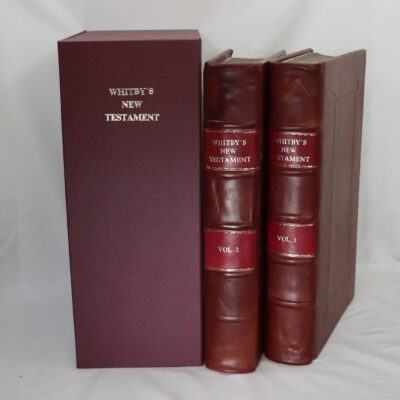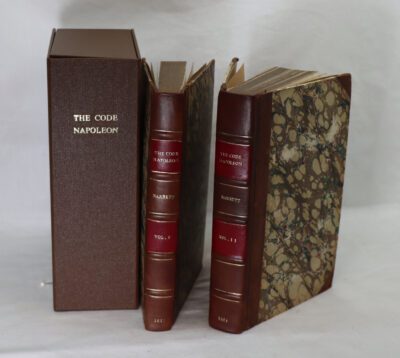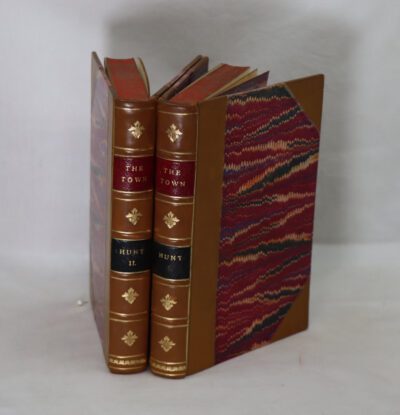Beckford's Vathek & Johnson's Rasselas.
By Samuel Johnson. William Beckford
Printed: 1883
Publisher: J C Nimmo & Bain. London
Edition: One thousand copies only
| Dimensions | 14 × 19 × 4 cm |
|---|---|
| Language |
Language: English
Size (cminches): 14 x 19 x 4
Condition: Fine (See explanation of ratings)
FREE shipping
Your items
Item information
Description
Full green calf with gilt decoration to boards and spine and dentelles. Marbled endpapers with cloth inner joints. Professionally re-backed in dyed calf with spine overlaid.
F.B.A. provides an in-depth photographic presentation of this item to stimulate your feel and touch. More traditional book descriptions are immediately available.
Unique!
A beautiful, refurbished compilation of two books
Vathek (alternatively titled Vathek, an Arabian Tale or The History of the Caliph Vathek) is a Gothic novel written by William Beckford. It was composed in French beginning in 1782, and then translated into English by Reverend Samuel Henley in which form it was first published in 1786 without Beckford’s name as An Arabian Tale, From an Unpublished Manuscript, claiming to be translated directly from Arabic. The first French edition, titled simply as Vathek, was published in December 1786 (postdated 1787). In the twentieth century some editions include The Episodes of Vathek (Vathek et ses épisodes), three related tales intended by Beckford to be so incorporated but omitted from the original edition and published separately long after his death.
William Beckford wrote Vathek in French in 1782, when he was 21. He often stated that Vathek was written as an emotional response to “the events that happened at Fonthill at Christmas 1781”, when he had prepared an elaborate Orientally-inspired entertainment at his lavish country estate with the assistance of renowned painter and set designer Philip James de Loutherbourg. Beckford said that it took him only two to three days and the intervening nights to write the entire book.
Vathek was written during a time when part of European culture was influenced by Orientalism. It is an Arabian tale because of the oriental setting and characters and the depiction of oriental cultures, societies, and myth. Vathek is also a Gothic novel with its emphasis on the supernatural, ghosts, and spirits, as well as the terror it tries to induce in the reader.
The title character is inspired by al-Wathiq, son of al-Mu’tasim, an Abbasid caliph who reigned in 842–847 (227–232 AH in the Islamic calendar) who had a great thirst for knowledge and became a great patron to scholars and artists. During his reign, a number of revolts broke out. He took an active role in quelling them. He died of fever on 10 August 847.
The narrative of Vathek uses a third person, omniscient, semi-intrusive narrator. The novel, while it may lend itself to be divided into chapters, is one complete manuscript without pause.
The History of Rasselas, Prince of Abissinia, originally titled The Prince of Abissinia: A Tale, though often abbreviated to Rasselas, is an apologue about bliss and ignorance by Samuel Johnson. The book’s original working title was “The Choice of Life”. The book was first published in April 1759 in England. Early readers considered Rasselas to be a work of philosophical and practical importance and critics often remark on the difficulty of classifying it as a novel.
At the age of fifty, Johnson wrote the piece in only one week to help pay the costs of his mother’s funeral, intending to complete it on 22 January 1759 (the eve of his mother’s death). Johnson is believed to have received a total of £75 for the copyright. Though this is still popular belief, Wharton and Mayerson’s book, “Samuel Johnson and the Theme of Hope,” explains how James Boswell, the author of Johnson’s biography, was “entirely wrong in supposing that Rasselas was written soon after his mother’s death”. It wasn’t a way of “defraying” the expenses of the funeral. In fact, Johnson wrote Rasselas instead of going to see his mother while she was still alive. It was written in anticipation of her funeral. Edward Tomarken writes in his book, Johnson, Rasselas, and the Choice of Criticism, that this belief was not questioned until 1927 as “…the tradition of the gloomy, funereal tone of the choice of life motif in Rasselas remained unopposed: the question of whether or not the genesis of Rasselas involved a literal funeral was not considered important. Moreover, the assumption of a gloomy genesis served to keep religion in the background, for any theological difficulty could be attributed to the fact that the author was mourning the death of his mother”.
Following in the footsteps of Voltaire’s Zadig and Montesquieu’s Persian Letters, Johnson was influenced by the vogue for exotic locations including Ethiopia. He had translated A Voyage to Abyssinia by Jerónimo Lobo in 1735 and used it as the basis for his “philosophical romance”. Ten years before he wrote Rasselas he published The Vanity of Human Wishes in which he describes the inevitable defeat of worldly ambition.
This idea of a prince condemned to a happy imprisonment has resonance – Johnson himself was probably ignorant of it – in the legend of Buddha, though it would have reached him through the story of Barlaam and Josaphat, adopted as the subject of one of Lope de Vega’s comedies: the idea of a prince who has been brought up surrounded with artificial happiness.
— Jorge Luis Borges
Although many have argued that the book Rasselas had nothing to do with Abyssinia, and that Samuel Johnson chose Abyssinia as a locale for no other reason than wanting to write an anti-orientalist fantasy, some have begun to argue that the book has a deep tie to Ethiopian thought due to Johnson’s translation of A Voyage to Abyssinia and his lifelong interest in its Christianity. Other scholars have argued that Johnson was influenced, at least in part, by other texts, including works by Herodotus and Paradise Lost.
According to Wendy L. Belcher, when Johnson sent his manuscript to the publisher he titled the work “The History of – – – – Prince of Abissinia,” which suggests that he had still not decided on the name of his protagonist. It is Belcher’s argument that “Johnson coined the name ‘Rasselas’ for its symbolic meaning, not its phonetic relation to the Catholic prince ‘Ras Sela Christos.’ Since ‘ras’ means ‘prince’ and ‘sela’ means ‘portrait’, Johnson may have invented the term ‘portrait of a prince’ as an evocative name for his main character.”
Condition notes
Want to know more about this item?

Share this Page with a friend















